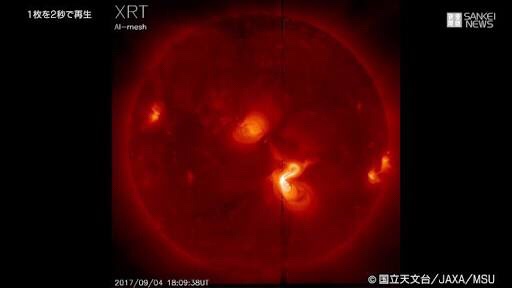
Nagoya University: New method for solar flare prediction: Elucidation of generation conditions
Nagoya University:
Teams such as Nagoya University announced in the US science magazine Science on 31st.
Clarification of solar flare generation conditions:
Solar flares affect social life such as power outages and communication failures.
We have clarified the conditions under which an explosion “solar flare” occurs on the surface of the sun, and developed a method for accurately predicting the location and scale of giant flares.
10-year data analyzed using this method:
As a result of analyzing the data of the last 10 years with this method,
It turned out that 7 of the 9 flares were caught.
It is expected to improve the accuracy of the “space weather forecast” that predicts flares.
Professor Kusano of Nagoya University: (Solar and Earth Environmental Physics)
“It’s the world’s first way to predict rare flare-ups. You can take action before it affects your society,” he said.
KYODO communication
https://this.kiji.is/661629804554814561
A physics-based method that can predict imminent large solar flares Predicting large solar flares
The sudden release of magnetic energy on the Sun drives powerful solar flares, which are difficult to predict.
Kusano et al.
derived physics-based thresholds for the onset of large solar flares and show how they can be predicted from routine solar observations (see the Perspective by Veronig).
They tested their method using observations of the Sun from 2008 to 2019.
In most cases, the method
correctly identifies which regions will produce large flares within the next 20 hours, although there are some false positives and false negatives.
The method also provides the exact location where each flare will begin and limits on how powerful it will be.
Accurate predictions of solar flares could improve forecasts of space weather conditions around Earth.
Science, this issue p. 587; see also p. 504
Abstract
Solar flares
are highly energetic events in the Sun’s corona that affect Earth’s space weather.
The mechanism
that drives the onset of solar flares is unknown, hampering efforts to forecast them, which mostly rely on empirical methods.
We present the κ-scheme,
a physics-based model to predict large solar flares through a critical condition of magnetohydrodynamic instability, triggered by magnetic reconnection.
Analysis of the largest (X-class) flares from 2008 to 2019 (during solar cycle 24)
shows that the κ-scheme predicts most imminent large solar flares, with a small number of exceptions for confined flares.
We conclude that
magnetic twist flux density, close to a magnetic polarity inversion line on the solar surface, determines when and where solar flares may occur and how large they can be.
https://www.sciencemag.org/about/science-licenses-journal-article-reuse
Science